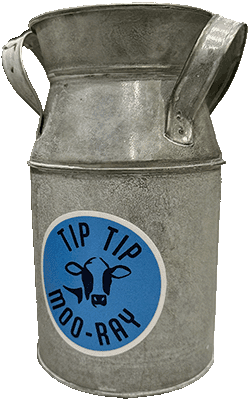Labels are required to inform consumers that the raw milk they are purchasing has not been pasteurized or otherwise sterilized, state-by-state, in many states.
Since untreated raw milk can contain pathogens similar to lettuce, in much lower numbers per consumer, labeling is important to ensure customer awareness that raw milk poses dissimilar risk compared to common processed fluid milk. Whether the consumer is drinking the raw milk or making raw milk cheese, labeling lets us know what we’re getting.
Examples of raw milk labels
Delaware: here’s the full section of the law pertaining to fresh (fluid) milk, including raw milk. Raw milk bill signed 9/26/2024:
§ 3177. Labeling of fresh and raw milk.
(a) A container of milk may be labeled as “fresh” only if the milk has not been dehydrated, rehydrated, or reconstituted in whole or in part and does not contain caseins, casein products, or caseinates other than those caseins, casein products, or caseinates which occur naturally.
(b) A container of raw milk or the packaging of a product derived from raw milk must include a prominent label stating that raw milk is unprocessed, unpasteurized, and unhomogenized and may contain harmful bacteria.
Louisiana: raw milk labeling text and size are defined. Raw milk legalized in Louisiana:
§1394. Labeling requirements A. Before any feed is made available for sale, the registrant shall file with the commission the following information for each brand of feed to be made available for sale in the state:
(14) If the feed is raw milk:
(a) The express words “WARNING: NOT FOR HUMAN CONSUMPTION – THIS PRODUCT HAS NOT BEEN PASTEURIZED AND MAY CONTAIN HARMFUL BACTERIA”.
(warning label sizing is prescribed)
(b) When pet food or specialty pet food consists of raw milk, the words, “Raw (blank) Milk” shall appear conspicuously on the principal display panel. “Blank” is to be completed by using the species of animal from which the raw milk is collected.
View the raw milk laws library and map
Size and visibility requirements
Raw milk labeling is governed state-by-state, each state will have its own requirements. Some states require the label to be of a certain size, with warning language, other states simply require the title of the product to contain the words “raw milk.”
Do raw milk labels increase sales?
Yes, raw milk is sought after, the label lets customers know they are getting a raw food. While some consumers may avoid raw milk, other consumers are seeking out unpasteurized milk specifically and will attract to the opportunity to get raw milk.
Do raw milk labels deter consumers?
No, labels are not a form of deterrence. We are all taught about pasteurization in grade school, people who seek out and choose raw milk do so with consideration. Deterrence perspectives stem from a paternalistic view of public health, rooted in social validation and not the data. It’s not a perspective we can entertain.
Are people accidentally buying raw milk?
This is not likely. Raw milk is usually placed in a separate area away from the conventional milk, often near organic milk brands. While raw milk can cost around the same amount as on-site vat-pasteurized milk from small farms, the price is generally much greater than conventional milk. When someone usually spends 3 or 4 dollars on a gallon of milk, 10 or 18 dollars per gallon is noticeable.
If those factors didn’t make the customer aware they were purchasing raw milk, a prominent label provides notice.




